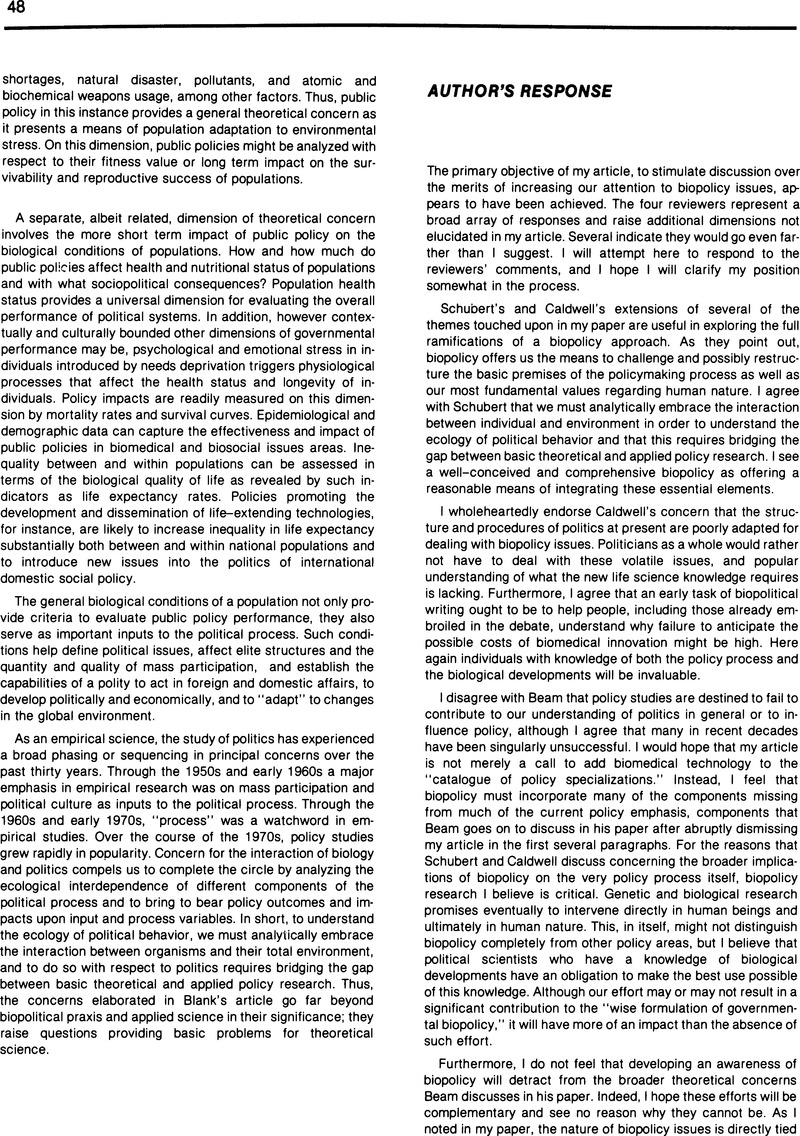No CrossRef data available.
Article contents
Abstract
An abstract is not available for this content so a preview has been provided. Please use the Get access link above for information on how to access this content.

- Type
- Articles and Commentaries
- Information
- Copyright
- Copyright © Association for Politics and the Life Sciences
References
Beam, D.R. (1981). “Altruism vs. Egoism in Public Policy: Hobbes, Darwin, and Humankind.” Paper presented at the meeting of the American Political Science Association, New York.Google Scholar
Blank, R.H. (1980). “Biopolitics: A Policy Perspective.” Notes 3(January 1980). DeKalb, III.: Center for Biopolitical Research.Google Scholar
Caldwell, L. K. (1964). “Biopolitics: Science, Ethics and Public Policy.” The Yale Review 54:1–16.Google Scholar
Caldwell, L. K. (1979). “Implications of Biopolitics: Reflections on a Politics of Survival.” Paper presented at the meeting of the International Society of Political Psychology, Washington, D.C.Google Scholar
Churchill, L.R., and Sim'an, Jose Jorge (1982). “Abortion and the Rhetoric of Individual Rights.” The Hastings Center Report 12:9–12.Google Scholar
Coates, J.F. (1978). “What Is a Public Policy Issue?” In Hammond, R. K. (ed.), Judgment and Decision in Public Policy Formation. Boulder, Colo.: Westview Press.Google Scholar
Coates, J.F. (1972). Technology and Public Policy: The Process of Technology Assessment in the Federal Government. Program of Policy Studies in Science and Technology, vol. 1. Washington, D.C.: George Washington University.Google Scholar
Coleman, F. M. (1977). Hobbes and America: Exploring the Constitutional Foundations. Toronto: University of Toronto Press.Google Scholar
Conklin, B. R., and Seiden, R. (1981). Public Affairs Report: Bulletin of the Institute of Governmental Studies (October). Berkeley, Calif.: University of California.Google Scholar
Corning, Peter A. (1978). “Biopolitics: Toward a New Political Science.” Paper presented at the meeting of the American Political Science Association, New York.Google Scholar
de Jouvenal, B. (1965). “Political Science and Prevision.” American Political Science Review 59:29–38.Google Scholar
Department of Health and Human Services (1978). Special Study: Implications of Advances in Biomedical and Behavioral Research. Report to the National Commission for the Protection of Human Subjects of Biomedical and Behavioral Research. Washington, D.C.: U.S. Government Printing Office.Google Scholar
Eibl-Eibesfeldt, I. (1979). The Biology of Peace and War: Men, Animals, and Aggression. New York: Viking Press.Google Scholar
Easton, David (1965). A Framework for Political Analysis. Englewood Cliffs, N.J.: Prentice-Hall.Google Scholar
Etzioni, A. (1973). Genetic Fix: The Next Technological Revolution. New York: Harper and Row.Google Scholar
Farber, S. L. (1981). Identical Twins Reared Apart: A Reanalysis. New York: Basic Books.Google Scholar
Fishbein, H. D. (1976). Evolution, Development, and Children's Learning. Pacific Palisades, Calif.: Goodyear Publishing Company.Google Scholar
Fletcher, J.F. (1974). The Ethics of Genetic Control: Ending Reproductive Roulette. New York: Doubleday.Google Scholar
Grobstein, C. (1981). From Chance to Purpose: An Appraisal of External Human Fertilization. Reading, Mass.: Addison–Wesley.Google Scholar
Hammond, R. K., ed. (1978). Judgment and Decision in Public Policy Formation. Boulder, Colo.: Westview Press.Google Scholar
Jenkins, I. (1980). Social Order and the Limits of Law: A Theoretical Essay. Princeton, N.J.: Princeton University Press.Google Scholar
Lappe, M. (1979). Genetic Politics: The Limits of Biological Control. New York: Simon and Schuster.Google Scholar
Lepawsky, A. (1967). “Medical Science and Political Science.” The Journal of Medical Education 42:905–917.Google Scholar
Lewis, J. D. (1982). “Technology, Enterprise, and American Economic Growth.” Science 215:1205–1211Google Scholar
Lipson, Leslie (1960). The Great Issues of Politics. Englewood Cliffs, N.J.: Prentice–Hall.Google Scholar
Mace, G. (1979). Locke, Hobbes, and The Federalist Papers: An Essay on the Genesis of the American Political Heritage. Carbondale, III.: Southern Illinois University Press.Google Scholar
Murchison, C., ed. (1926). Psychologies of 1925. Worcester, Mass.: Clark University Press.Google Scholar
Poole, J. R. (1978). The Pursuit of Equality in American History. Berkeley, Calif.: University of California Press.Google Scholar
Schoenberg, B. (1979). “Science and Anti–Science in Confrontation.” Man and Medicine 4:79–102.Google Scholar
Sears, D. D. et al. (1980). “Self–interest vs. Symbolic Politics in Policy Attitudes and Presidential Voting.” American Political Science Review 74:670–684.Google Scholar
Service, E. R. (1975). Origins of the State and Civilization: The Process of Cultural Evolution. New York: W. W. Norton.Google Scholar
Somit, A., and Peterson, S. (1979). “Biopolitics: 1978.” Notes 2 (October 1979). DeKalb, III.: Center for Biopolitical Research.Google Scholar
Thompson, M., and Milunsky, A. (1979). “Policy Analysis for Prenatal Genetic Diagnosis.” Public Policy 27:25–48.Google Scholar
Tsuang, Ming T., and Vandermey, R. (1980). Genes and the Mind: Inheritance of Mental Illness. New York: Oxford University Press.Google Scholar
Wahlke, J. C. (1979). “Pre–Behavioralism in Political Science.” American Political Science Review 73:9–31.Google Scholar
Watson, J. B. (1926). “What the Nursery Has to Say About Instincts.” In Murchison, C. (ed.), Psychologies of 1925. Worcester, Mass.: Clark University Press.Google Scholar
Weiss, M. L., and Mann, A. E. (1975). Human Biology and Behavior: An Anthropological Perspective. Boston: Little, Brown and Company.Google Scholar
Wenke, R. J. (1980). Patterns in Prehistory: Mankind's First Three Million Years. New York: Oxford University Press.Google Scholar
Wiegele, Thomas C. (1979). Biopolitics: The Search for a More Human Political Science. Boulder, Colo.: Westview Press.Google Scholar
Wiegele, Thomas C. (1982). “Is a Revolution Brewing in the Social Sciences?” In Wiegele, Thomas C. (ed.), Biology and the Social Sciences. Boulder, Colo.: Westview Press.Google Scholar
Williams, F. (1982). The Communications Revolution. Beverly Hills, Calif.: Sage Publications.Google Scholar
Wilson, J. Q. (1980). “‘What Works?’ Revisited: New Findings on Criminal Rehabilitation.” The Public Interest 61:3–17.Google Scholar


